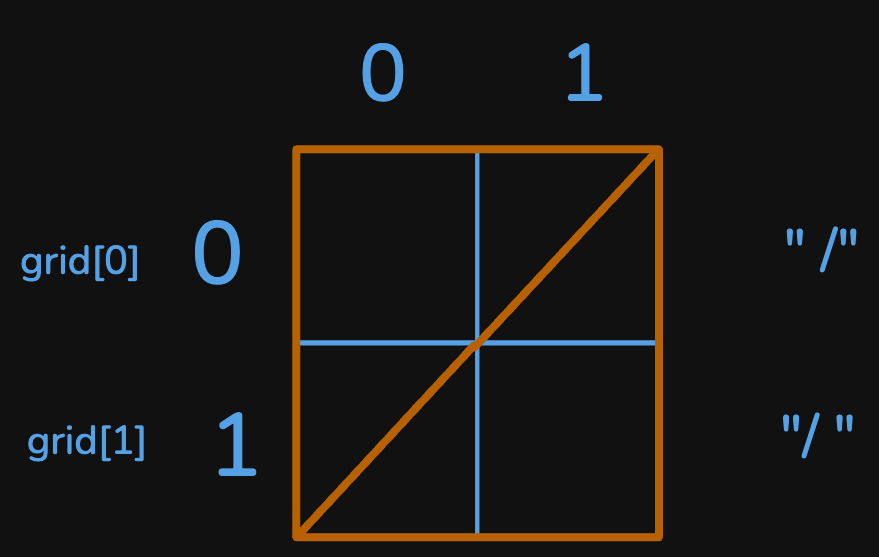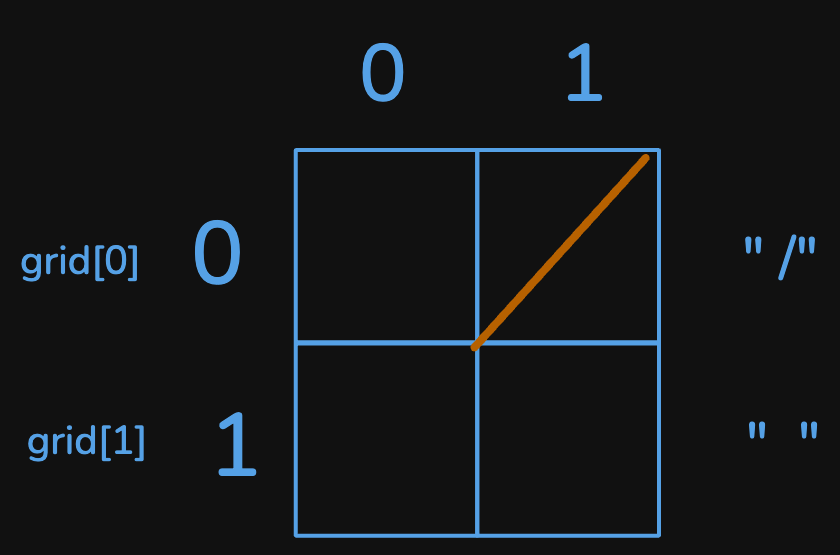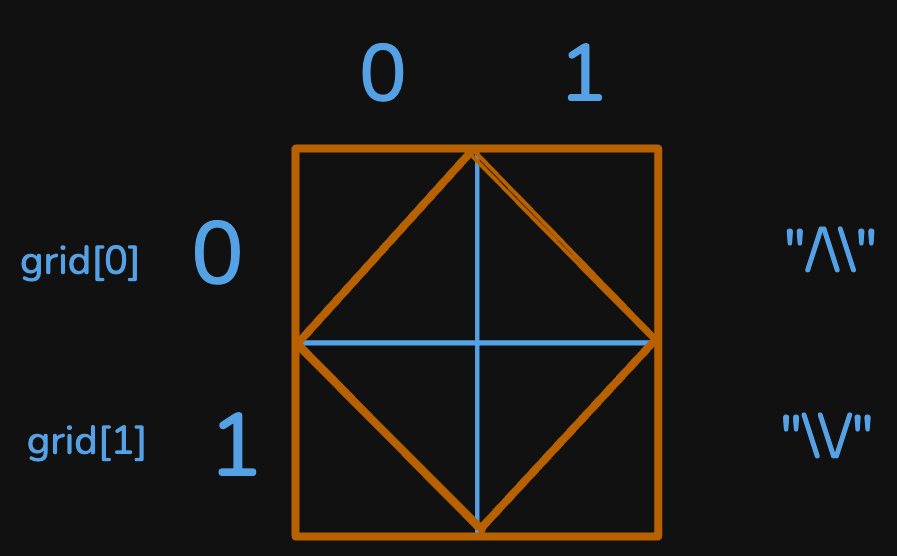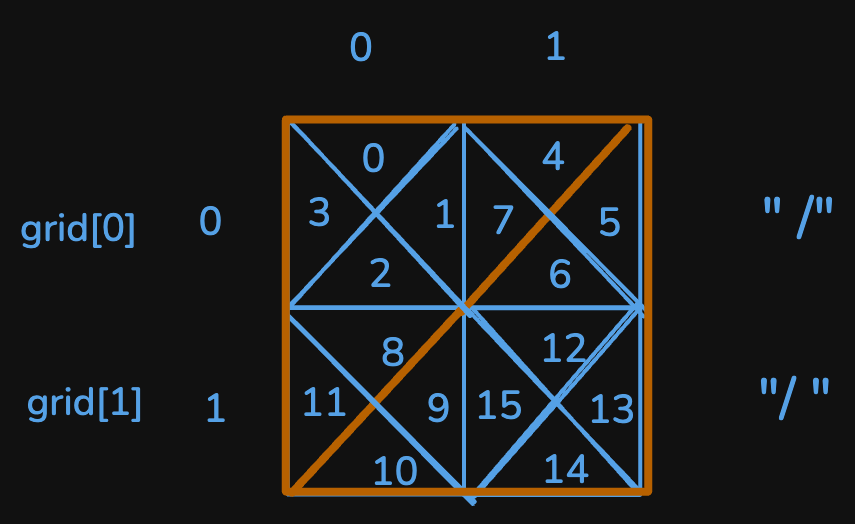Regions Cut By Slashes
Problem
An n x n grid is composed of 1 x 1 squares where each 1 x 1 square consists of a '/', '\', or blank space ' '. These characters divide the square into contiguous regions.
Given the grid grid represented as a string array, return the number of regions.
Note that backslash characters are escaped, so a '\' is represented as '\\'.
Examples
Example 1:
Input: grid = [" /","/ "]
Output: 2
Explanation: This is 2x2 grid:

Example 2:
Input: grid = [" /"," "]
Output: 1

Example 3:
Input: grid = ["/\\","\\/"]
Output: 5
Explanation: Recall that because \ characters are escaped, "\\/" refers to \/, and "/\\" refers to /\.

Solution
Method 1 - Using Union Find
Each 1x1 square is divided into 4 smaller triangles. We can label these triangles as follows:
- Top-left triangle: 0
- Top-right triangle: 1
- Bottom-left triangle: 2
- Bottom-right triangle: 3

So, we can use union find data structure to simulate that.
- Use the Union-Find structure to keep track of connected regions.
- Initialize the Union-Find structure to have ( n \times n \times 4 ) elements (each small triangle in the grid).
Code
Java
public class Solution {
public int regionsBySlashes(String[] grid) {
int n = grid.length;
int totalCells = n * n * 4;
UnionFind uf = new UnionFind(totalCells);
for (int r = 0; r < n; r++) {
for (int c = 0; c < n; c++) {
int base = 4 * (r * n + c);
char val = grid[r].charAt(c);
// Connect triangles within the cell
if (val == '/') {
uf.union(base, base + 3);
uf.union(base + 1, base + 2);
} else if (val == '\\') {
uf.union(base, base + 1);
uf.union(base + 2, base + 3);
} else {
uf.union(base, base + 1);
uf.union(base + 1, base + 2);
uf.union(base + 2, base + 3);
}
// Connect triangles with neighboring cells
// Connect with the right cell
if (c + 1 < n) {
uf.union(base + 1, 4 * (r * n + (c + 1)) + 3);
}
// Connect with the bottom cell
if (r + 1 < n) {
uf.union(base + 2, 4 * ((r + 1) * n + c));
}
}
}
return uf.getNumComponents();
}
static class UnionFind {
private int[] parent;
private int[] rank;
private int numComponents;
public UnionFind(int size) {
this.numComponents = size;
makeSet();
}
public void makeSet() {
rank = new int[numComponents];
parent = new int[numComponents];
for (int i = 0; i < parent.length; i++) {
parent[i] = i;
rank[i] = 0;
}
}
public boolean union(int i, int j) {
int rootI = find(i);
int rootJ = find(j);
if (rootI == rootJ) {
return false;
}
// make parent with higher rank
if (rank[rootI] < rank[rootJ]) {
parent[rootI] = rootJ;
} else if (rank[rootI] > rank[rootJ]) {
parent[rootJ] = rootI;
} else {
// equal case
parent[rootJ] = rootI;
rank[rootI]++;
}
numComponents--;
return true;
}
public int find(int i) {
while (parent[i] != i) {
i = parent[i];
}
return i;
}
public int getNumComponents() {
return numComponents;
}
public boolean isConnected(int i, int j) {
return find(i) == find(j);
}
public int count() {
return numComponents;
}
}
}
Complexity
- ⏰ Time complexity:
O(n^2)- The outer loops iterate through every cell in an ( n \times n ) grid. Thus, the number of iterations is ( O(n^2) ).
- Within each cell, for each of the 4 triangles, we perform union operations.
- Each union operation and find operation in the Union-Find structure are amortized ( O(\alpha(N)) ), where ( \alpha ) is the inverse Ackermann function, which grows very slowly and is practically constant for typical input sizes.
- Given that we perform a constant number (up to 12) of union/find operations per cell, this step is ( O(1) ) per cell.
- 🧺 Space complexity:
O(n^2)- We use a Union-Find structure to manage ( 4 \times n \times n ) elements.
- The space required for the parent and rank arrays is ( O(4 \times n^2) = O(n^2) ).
Dry Run
Lets take eg. 1, then, we have:
Input: grid = [" /","/ "]
So, we have grid like:

Initially n = 4, For each 1x1 cell, we'll divide it into four smaller triangles, numbered 0 to 3, this is how our grid looks with 16 triangles in it, labeled 0 to 15:

Processing each cell
Cell (0, 0) = " " ⇨ union(0, 1), union(1, 2), union(2, 3)
Cell (0,1) = "/" ⇨ union(4, 7), union(5, 6)
Cell (1, 0) = "/" ⇨ union(8, 11), union(9, 10)
Cell (1, 0) = " " ⇨ union(12, 13), union(13, 14), union(14, 15)
Connecting neighbouring cells
- Between (0, 0) and (0, 1): Union(1, 7)
- Between (0, 1) and (1, 1): Union(7, 15)
- Between (0, 0) and (1, 0): Union(2, 8)
- Between (1, 0) and (1, 1): Union(10, 12)
Final answer
This is how number of components in 2.